Railway History
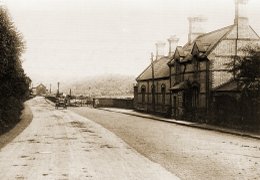 The Furness Railway was developed during the 1850’s and 1860’s, at the height of the Industrial Revolution, in order to transport the coal and iron ore deposits from mines in the coastal areas of Cumberland and the Furness district of Lancashire to the heavy industries of the North West and North East of England.
The Furness Railway was developed during the 1850’s and 1860’s, at the height of the Industrial Revolution, in order to transport the coal and iron ore deposits from mines in the coastal areas of Cumberland and the Furness district of Lancashire to the heavy industries of the North West and North East of England.
When the various companies had completed a railway system around the coast from Carlisle to Lancaster, the Furness Railway Company quickly realised that there was a potential for personal travel and tourism because, for the first time, here was a fast and easy mode of transport for the masses. In fact, as early as 1847, the Kendal and Windermere Railway Company had opened a branch line from the new Lancaster and Carlisle Railway; this branch from Oxenholme terminated at Birthwaite (which was later to develop as the modern town of Windermere), and by 1850, four passenger steamers plied the length of the lake from Waterhead to Newby Bridge (a distance of about 11½ miles).
Construction
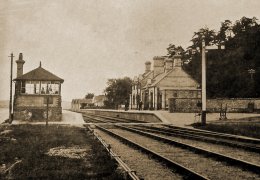 The Furness Railway, with an eye to the future built a line from Plumpton Junction (near Ulverston) along the River Leven estuary to Greenodd. A final decision was then made to build an extension up the valley to Newby Bridge, so on the 22nd November 1866, Mr. James Ramsden, the General Manager of the Furness Railway and a major landowner and industrialist, cut the first sod at Haverthwaite.
The Furness Railway, with an eye to the future built a line from Plumpton Junction (near Ulverston) along the River Leven estuary to Greenodd. A final decision was then made to build an extension up the valley to Newby Bridge, so on the 22nd November 1866, Mr. James Ramsden, the General Manager of the Furness Railway and a major landowner and industrialist, cut the first sod at Haverthwaite.
Construction of the line commenced the following year, but the difficult tunnelling and cutting through the hard rocks around Haverthwaite soon put the work behind schedule. Meanwhile, a decision was made to extend the line beyond Newby Bridge with a new terminus at Lakeside a mile further on, which would allow larger steamers to operate. Shares were purchased in the Windermere United Steam Yacht Co. to prevent any possible expansionist plans of the Kendal and Windermere Railway which by now was part of the London & North Western Railway. The intentions of the Furness Railway Company were now very clear.
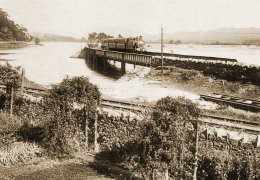 The line, of 7 miles and 73 chains (7.9 miles or 12.7km), was opened with great ceremony on the 1st June 1869, although the stations along the route were not yet completed.
The line, of 7 miles and 73 chains (7.9 miles or 12.7km), was opened with great ceremony on the 1st June 1869, although the stations along the route were not yet completed.
The main revenue earner for the line was freight, this being coal for the Windermere steamers, iron ore for the Backbarrow Iron Works, and sulphur and saltpetre for the Black Beck and Low Wood gunpowder works. The traffic in the opposite direction was mainly pig iron, gunpowder, pit props, ultramarine ‘blue’ powder, wooden bobbins (from the Finsthwaite area) and livestock.
In Decline
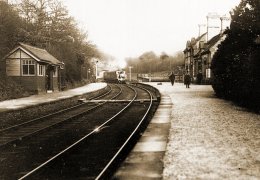 By 1872, the steamers of the United Windermere Steam Yacht Company had been purchased outright by the Furness Railway but unfortunately, at the same time the iron ore industry started to decline and, with it, the fortunes of the Furness Railway.
By 1872, the steamers of the United Windermere Steam Yacht Company had been purchased outright by the Furness Railway but unfortunately, at the same time the iron ore industry started to decline and, with it, the fortunes of the Furness Railway.
At the turn of the century, with a more modern fleet of vessels on the lake, the Furness Railway was in an ideal position to encourage and carry train loads of day trippers and holiday-makers. The golden years of the branch had begun, and were to reach a peak just before the Great War, the traffic gradually tailing off as the motor car became more popular.
In 1938, for the first time, the passenger service was suspended for the winter. Then with the advent of war in 1939, the winter service was again suspended, never to operate again and, in fact, the wartime summer service ran only until 1941. Newby Bridge Halt was closed in September 1939, but occasionally used for the transfer of German prisoners of war from Grizedale Hall POW camp. Nonetheless, the line was busy with freight throughout this difficult period.
Closure
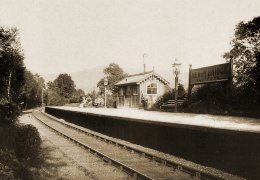 In 1946 the summer passenger service was reintroduced, but in September of the same year, Haverthwaite and Greenodd stations were closed to passengers, the final blow falling on the 5th September 1965 when the whole line was closed to passenger traffic, remaining open for freight only as far as Haverthwaite and Backbarrow Iron works. The Iron Works closed and the twice weekly service terminated on the 2nd April 1967. A Stanier Black 5, with a brake van “enthusiasts special” was the last British Railways train to visit Lakeside on the 2nd September 1967.
In 1946 the summer passenger service was reintroduced, but in September of the same year, Haverthwaite and Greenodd stations were closed to passengers, the final blow falling on the 5th September 1965 when the whole line was closed to passenger traffic, remaining open for freight only as far as Haverthwaite and Backbarrow Iron works. The Iron Works closed and the twice weekly service terminated on the 2nd April 1967. A Stanier Black 5, with a brake van “enthusiasts special” was the last British Railways train to visit Lakeside on the 2nd September 1967.
Unfortunately, during the period between closure in 1965 and re-opening in 1973, most of the Lakeside station was demolished apart from the quayside office of Sealink and the Cafeteria above. The overall roof was the last to go, this being removed as unsafe by the owners of the site (British Rail Property Board) during the winter of 1978, so that sadly, little now remains to remind the visitor of the station in its Edwardian heyday.?
Salvation
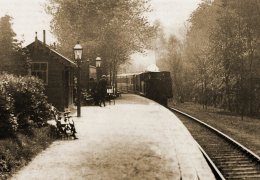 In the early 1960’s, Mr Austin Maher, a Lancashire businessman was talking to his brother Charles, a farmer living near Kendal about the forthcoming end of steam on British Railways and the subsequent scrapping of their steam locomotives.
In the early 1960’s, Mr Austin Maher, a Lancashire businessman was talking to his brother Charles, a farmer living near Kendal about the forthcoming end of steam on British Railways and the subsequent scrapping of their steam locomotives.
As both men were keen cine-photographers, Austin suggested to his brother that he might like to take some film on Shap Fell while on his regular run to Penrith cattle Market, thus providing a photographic record before steam was gone forever.
Late in the summer of 1965, Charles accompanied Mr Taffy Owen, an engine driver friend from Carnforth shed, on the footplate of class 5 locomotive No. 45227, hauling a special train know as the “Lake Windermere Cruise” from Blackpool to Lakeside. The journey enabled a film of the branch to be made before closure. Early in 1966, when showing this film to friends in Carnforth, the brothers were introduced to Dr. Peter Beet and Mr John Parkin, who had previously expressed an interest in forming a company to save the branch and to eventually re-open it using steam traction.
The Lakeside Railway Estates Company was formed with Dr. Beet as Chairman and Mr. Parkin as a director. Later Mr Austin Maher and others joined the company.
Negotiations
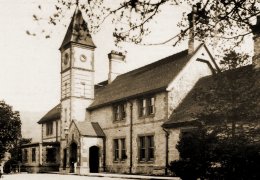 The purchasing of locomotives for possible future use on the branch started in 1967, and they were stored at the Carnforth Motive Power Depot of British Railways. Also in 1967, a supporters group, the “Lakeside Railway Society” was formed from the Lancashire Railway Circle to help the new venture.
The purchasing of locomotives for possible future use on the branch started in 1967, and they were stored at the Carnforth Motive Power Depot of British Railways. Also in 1967, a supporters group, the “Lakeside Railway Society” was formed from the Lancashire Railway Circle to help the new venture.
Simultaneously, serious negotiations with British Rail Property Board commenced regarding the purchase of the whole branch line, but unfortunately, the Property Board would not consider the offers of the company. At that time any public utility had absolute preference in negotiations for BR property over any private purchaser and the Lake District Planning Board was adamant that it wanted to convert the trackbed of the Haverthwaite to Lakeside section into a footpath.
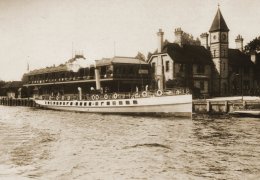 Throughout 1967, the local Member of Parliament, Mr. A. G. F Hall-Davis, did all within his power to further the cause of the re-opening of the line, even enlisting the help of the Minister of Transport, Mrs. Barbara Castle, who decreed that the branch could not be dismantled without her approval. In spite of this, throughout 1968, the Lake District Planning Board under Mr. Himsworth still held out against the company. The breakthrough occurred in mid 1969, when, influenced by a massively supported petition organised by the Lakeside Railway Society, the Planning Board withdrew its main oppositions to the revival scheme.
Throughout 1967, the local Member of Parliament, Mr. A. G. F Hall-Davis, did all within his power to further the cause of the re-opening of the line, even enlisting the help of the Minister of Transport, Mrs. Barbara Castle, who decreed that the branch could not be dismantled without her approval. In spite of this, throughout 1968, the Lake District Planning Board under Mr. Himsworth still held out against the company. The breakthrough occurred in mid 1969, when, influenced by a massively supported petition organised by the Lakeside Railway Society, the Planning Board withdrew its main oppositions to the revival scheme.
Setbacks from the Trunk Road
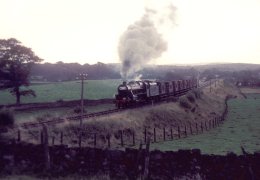 In 1968, British Railways decreed that it would not allow privately operated trains into Ulverston (although the Company’s plan had always been to build a new station at Plumpton Junction). During the same year, the trunk road authorities made it known that they wished to use a large part of the Haverthwaite Station yard and sections of the track bed for improvements to the A590 trunk road. The authority was willing to bridge the railway below the Haverthwaite West tunnel and also across the Leven estuary at Greenodd so long as the company was prepared to pay for the motorway type bridges.
In 1968, British Railways decreed that it would not allow privately operated trains into Ulverston (although the Company’s plan had always been to build a new station at Plumpton Junction). During the same year, the trunk road authorities made it known that they wished to use a large part of the Haverthwaite Station yard and sections of the track bed for improvements to the A590 trunk road. The authority was willing to bridge the railway below the Haverthwaite West tunnel and also across the Leven estuary at Greenodd so long as the company was prepared to pay for the motorway type bridges.
This disastrous situation was to have two far-reaching consequences; firstly that Haverthwaite yard would in future be cramped and desperately lacking in space necessary for expansion or improvements, and secondly, since Dr. Beet’s embryonic company did not have the financial resources to both purchase the line and build these bridges. This gave it no option but to abandon the fight to save the branch, deciding instead to concentrate on the creation of a museum at Carnforth Motive Depot, which at that time was due for closure by British Railways.
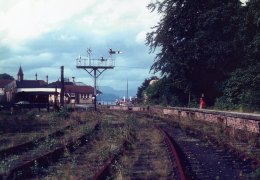 All was not lost, for two directors of the Lakeside Railway Estates Company, namely Mr. Jim Morris and Mr. Austin Maher together with the Company Secretary, Mr. David Piercy, formed a new company on the 26th March 1970, thus the Lakeside and Haverthwaite Railway Company Ltd. was born from the ashes of the previous company to continue the effort to save the upper 3½ miles of the branch.
All was not lost, for two directors of the Lakeside Railway Estates Company, namely Mr. Jim Morris and Mr. Austin Maher together with the Company Secretary, Mr. David Piercy, formed a new company on the 26th March 1970, thus the Lakeside and Haverthwaite Railway Company Ltd. was born from the ashes of the previous company to continue the effort to save the upper 3½ miles of the branch.
The Purchase
On the 27th May, 1970, the BR Property Board approved the sale of the line, provided that a light railway order be granted to British Railways, and a transfer order then be granted to the Lakeside and Haverthwaite Railway Company, and that guarantees be given that finance was available for the purchase.
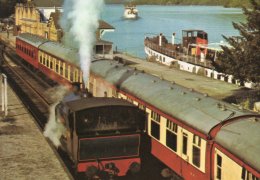 The Lakeside Railway Society was granted access to the line for tidying up purposes, and in October 1970, coaches (purchased from British Railways at York) were delivered to the line together with the available locomotives which had been stored at Carnforth. This movement was precipitated by the impending lifting of the remainder of the line, which actually took place in June 1971.
The Lakeside Railway Society was granted access to the line for tidying up purposes, and in October 1970, coaches (purchased from British Railways at York) were delivered to the line together with the available locomotives which had been stored at Carnforth. This movement was precipitated by the impending lifting of the remainder of the line, which actually took place in June 1971.
Negotiations with the Divisional Office of the Property Board dragged on without any progress being made whatsoever, but this changed after a meeting with the main board of the Estates Division of British Railways Midland Region and a Light Railway Order was applied for. This was further delayed by an objection from a member of the public to the granting of the order, being received on the 20th September 1972, so a public enquiry was arranged for October. On learning that he was the sole objector, this person, not having the courage of his convictions, withdrew, thus allowing the transfer of the order to be granted in early 1973.
The Lakeside and Haverthwaite Railway was then purchased by Mr. Austin Maher who had also been responsible for funding all the administration expenses of the previous years. Major P. M. Olver of the Railway Inspectorate then examined every aspect of the line and its proposed operating methods, giving his clearance for the reopening to passenger traffic.
The Re-opening
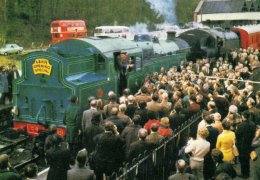 The re-opening on the 2nd May 1973, was a proud day for the Society members who had worked so hard to repair and restore the railway to the necessary operating standards and for the Company’s directors, its shareholders and friends it was a dream realised. A moment to be savoured by the now Chairman, Mr. Austin Maher, was when he asked Britain’s best known railway photographer, the Right Reverend Eric Treacy, LLD, Bishop of Wakefield, to cut the tape linking the lake steamer to locomotive 42085, which was at the head of the inaugural special train, together with its sister engine 42073. En-route to Haverthwaite a stop was made at Newby Bridge Halt, where the Bishop planted a copper beech tree to commemorate the beginning of a new life.
The re-opening on the 2nd May 1973, was a proud day for the Society members who had worked so hard to repair and restore the railway to the necessary operating standards and for the Company’s directors, its shareholders and friends it was a dream realised. A moment to be savoured by the now Chairman, Mr. Austin Maher, was when he asked Britain’s best known railway photographer, the Right Reverend Eric Treacy, LLD, Bishop of Wakefield, to cut the tape linking the lake steamer to locomotive 42085, which was at the head of the inaugural special train, together with its sister engine 42073. En-route to Haverthwaite a stop was made at Newby Bridge Halt, where the Bishop planted a copper beech tree to commemorate the beginning of a new life.
